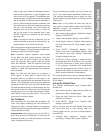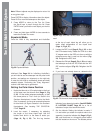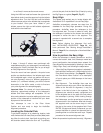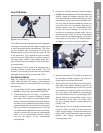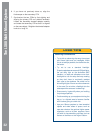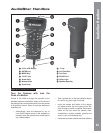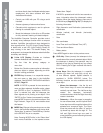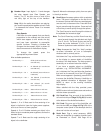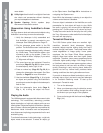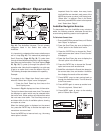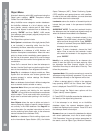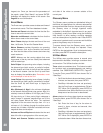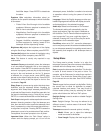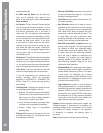
ᕦ Number Keys: Input digits 0 - 9 and changes
the slew speeds (see Slew Speeds, see
below). The “0” key also turns on and off the
red utility light on the top of the handbox.
Note: While the audio descriptions are playing,
the 7 and 9 keys adjust the speaker volume. Press
7 to decrease the volume. Press 9 to increase
the volume
Slew Speeds
LX80 has nine slew speeds that are directly
proportional to the sidereal rate (the rate at
which stars appear to drift across the sky)
and have been calculated to accomplish
specifi c functions. Pressing a Number key
changes the slew speed, which is shown for
about two seconds on AudioStar’s display.
To change the speed, press the
appropriate key shown below.
Nine available speeds are:
Number Key 1 = Guide (0.25 arc-min/sec
or 0.004°/sec)
Number Key 2 = 2x = 2x sidereal (0.5 arc-min/sec
or 0.008°/sec)
Number Key 3 = 8x = 8x sidereal (2 arc-min/sec or
0.033°/sec)
Number Key 4 = 16x = 16x sidereal (4 arc-min/sec
or 0.067°/sec)
Number Key 5 = 64x = 64x sidereal (16 arc-min
sec or 0.27°/sec)
Number Key 6 = 128x = 30arc-min/sec or 0.5°/sec
Number Key 7 = 1.5° = 90arc-min/sec or 1.5°/sec
Number Key 8 = 3° = 180arc-min/sec or 3°/sec
Number Key 9 = Max = 270arc-min/sec or 4.5°/sec
Speeds 1, 2 or 3: Best used for fi ne centering of an
object in the fi eld of view of a higher power eyepiece,
such as a 12mm or a 9mm eyepiece.
Speeds 4, 5 or 6: Enables centering an object in the
fi eld of a low-to-moderate power eyepiece, such as the
standard 26mm.
Speeds 7 or 8: Best used for rough centering of an
object in the viewfi nder.
Speed 9: Moves the telescope quickly from one point
in the sky to another.
ᕧ Scroll Keys: Accesses options within a selected
menu. The menu is displayed on the fi rst line of
the screen. Options within the menu are displayed,
one at a time, on the second line. Press the Scroll
keys to move through the options. Press and hold
a Scroll key to move quickly through the options.
The Scroll keys also scroll through the letters of
the alphabet and numerical digits.
Note: The Scroll Down key and the Down Arrow key
move forward through the alphabet and digits
(A to Z, 0 to 9). The Scroll Up key and the Up
Arrow key move backward (Z to A, 9 to 0).
Common symbols are also available in the list.
ᕨ ? Key: Accesses the “Help” fi le. “Help” provides
on-screen information on how to accomplish
whatever task is currently active.
Hold down the ? key and then follow the prompts
on the display to access details of AudioStar
functions in the Help feature. The Help system is
essentially an on-screen instruction manual.
If you have a question about an AudioStar
operation, e.g., INITIALIZATION, ALIGNMENT,
etc., hold down the ? key and follow the directions
that scroll on the second line of the LCD screen.
When a word appears in [brackets], press ENTER
to access the AudioStar Glossary. A defi nition or
more detailed information is displayed. Press
MODE to return to the scrolling AudioStar
Help display.
When satisfi ed with the Help provided, press
MODE to return to the original screen and continue
with the chosen procedure.
ᕩ Coil Cord Port: Plug one end of the AudioStar
coil cord into this port (Page 33, Fig 39, 9) located
at the bottom of the AudioStar handbox.
µ Coil Cord: Plug one end of the AudioStar coil
cord into the HBX port (Page 10, Fig 3, D) of the
computer control panel of the telescope and the
other end into the coil cord port.
¸ Serial Port: Plug a serial accessory (#505)
cable into AudioStar for updating functions such
as “Download” or “Clone”. See Page 43 for
35
AudioStar Handbox



